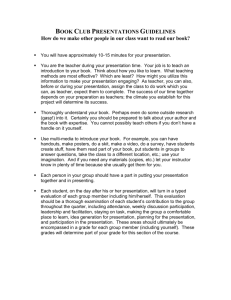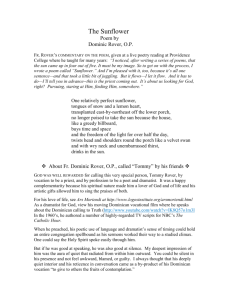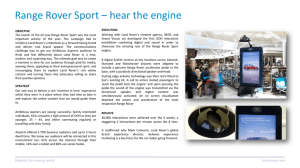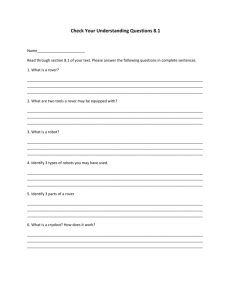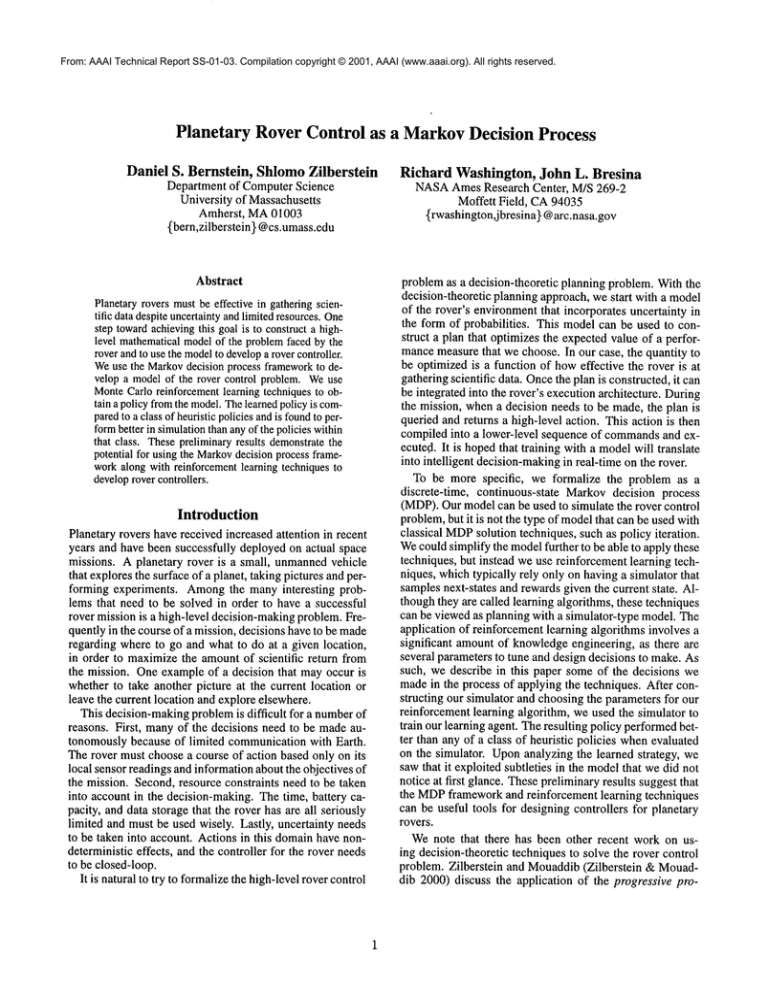
From: AAAI Technical Report SS-01-03. Compilation copyright © 2001, AAAI (www.aaai.org). All rights reserved.
Planetary Rover Control as a MarkovDecision Process
Daniel S. Bernstein, Shlomo Zilberstein
Department of ComputerScience
University of Massachusetts
Amherst, MA01003
{bern,zilberstein} @cs.umass.edu
Abstract
Planetaryrovers mustbe effective in gatheringscientific data despiteuncertaintyandlimitedresources.One
step towardachievingthis goal is to constructa highlevel mathematicalmodelof the problemfaced by the
roverandto use the modelto developa rovercontroller.
Weuse the Markovdecision process frameworkto develop a modelof the rover control problem.Weuse
MonteCarlo reinforcementlearning techniquesto obtain a policyfromthe model.Thelearnedpolicyis comparedto a class of heuristicpoliciesandis foundto performbetter in simulationthan anyof the policies within
that class. Thesepreliminaryresults demonstratethe
potential for using the Markov
decisionprocessframeworkalong with reinforcementlearning techniquesto
developrovercontrollers.
Introduction
Planetary rovers have received increased attention in recent
years and have been successfully deployed on actual space
missions. A planetary rover is a small, unmannedvehicle
that exploresthe surface of a planet, taking pictures and performing experiments. Amongthe manyinteresting problems that need to be solved in order to have a successful
rover mission is a high-level decision-makingproblem. Frequently in the course of a mission, decisions haveto be made
regarding where to go and what to do at a given location,
in order to maximizethe amountof scientific return from
the mission. One exampleof a decision that mayoccur is
whether to take another picture at the current location or
leave the current location and explore elsewhere.
This decision-makingproblemis difficult for a numberof
reasons. First, manyof the decisions need to be madeautonomously because of limited communicationwith Earth.
The rover must choose a course of action based only on its
local sensor readings and informationabout the objectives of
the mission. Second, resource constraints need to be taken
into account in the decision-making. The time, battery capacity, and data storage that the rover has are all seriously
limited and must be used wisely. Lastly, uncertainty needs
to be taken into account. Actions in this domainhave nondeterministic effects, and the controller for the rover needs
to be closed-loop.
It is natural to try to formalizethe high-levelrover control
Richard Washington, John L. Bresina
NASAAmesResearch Center, M/S 269-2
Moffett Field, CA94035
{rwashington,jbresina} @arc.nasa.gov
problemas a decision-theoretic planning problem. With the
decision-theoretic planning approach, we start with a model
of the rover’s environmentthat incorporates uncertainty in
the form of probabilities. This modelcan be used to construct a plan that optimizes the expected value of a performancemeasurethat we choose. In our case, the quantity to
be optimized is a function of howeffective the rover is at
gatheringscientific data. Oncethe plan is constructed, it can
be integrated into the rover’s executionarchitecture. During
the mission, whena decision needs to be made, the plan is
queried and returns a high-level action. This action is then
compiled into a lower-level sequence of commandsand executed. It is hopedthat training with a modelwill translate
into intelligent decision-makingin real-time on the rover.
To be more specific, we formalize the problem as a
discrete-time, continuous-state Markovdecision process
(MDP).Our modelcan be used to simulate the rover control
problem,but it is not the type of modelthat can be used with
classical MDP
solution techniques, such as policy iteration.
Wecould simplify the modelfurther to be able to apply these
techniques, but instead we use reinforcement learning techniques, whichtypically rely only on having a simulator that
samplesnext-states and rewards given the current state. Althoughthey are called learning algorithms, these techniques
can be viewedas planning with a simulator-type model. The
application of reinforcement learning algorithms involves a
significant amountof knowledgeengineering, as there are
several parameters to tune and design decisions to make. As
such, we describe in this paper someof the decisions we
madein the process of applying the techniques. After constructing our simulator and choosingthe parameters for our
reinforcement learning algorithm, we used the simulator to
train our learning agent. Theresulting policy performedbetter than any of a class of heuristic policies whenevaluated
on the simulator. Uponanalyzing the learned strategy, we
sawthat it exploited subtleties in the modelthat wedid not
notice at first glance. Thesepreliminaryresults suggest that
the MDPframeworkand reinforcement learning techniques
can be useful tools for designing controllers for planetary
rovers.
Wenote that there has been other recent work on using decision-theoretic techniques to solve the rover control
problem. Zilberstein and Mouaddib(Zilberstein & Mouaddib 2000) discuss the application of the progressive pro-
State Variable
Time Remaining
Battery Capacity
Data Storage
Difficulty
Importance
Tasks Accomplished
cessing frameworkto the problem. Bresina and Washington
(Bresina & Washington2000) study a way of incorporating
uncertainty into the Contingent Rover Language(CRL) for
rover control. Theselines of workare all closely related and
will likely informeach other in the future.
This paper is organized as follows. First, we formally describe the Markovdecision process framework. Then we
describe how the rover control problem can be formalized
as an MDP.Next, we discuss ways of using knowledge to
constrain the policy space. Wedescribe a class of heuristic policies within this space and a wayof using reinforcementlearning techniques to find a policy in this space. Experimental results with both the heuristic policies and the
learned policies are presented. Finally, we discuss the implications of the results and directions for future work.
Table1: The domainsof the state variables.
learned from them to guide the development of the more
complicated models.
Ourscenario can be described as follows. Thereis a rover
on Mars that communicateswith Earth exactly once each
Martian day. Because objectives can change significantly
due to communication,the horizon for planning is the start
of the next communication.Thus, an episode is the period
of time between two communications.Also, we assume that
the rover alwaysstarts an episode in the samestate So.
During its day, the rover must gather data from various
sites. Thereare several alternative waysto do this, and the
rover’s action choices dictate whichis implemented.The action set, A, contains four actions: abandonthe current site in
favor of a newsite, take a picture of the current site, perform
a spectrometer experimentat the current site, and wait for
the battery to recharge.
Havinglisted the actions, wenowdescribe the set of states
for whichthe rover must choose an action. Resource levels
comprisethree of the state features. Theseinclude the time
remaining until the next communication,the battery capacity, and the storage available. Timeand storage are nonrenewable resources. Battery capacity, on the other hand,
can actually increase during the day. In our model, during
the entire middlethird of the day, the capacitylevel is at its
maximum.
This is a simplified modelof the sun being in the
right position to charge the battery.
In addition to the resource levels, information about the
current site is included as part of the state. Onepiece of
informationis the difficulty of the current site. This is related to the probability that the rover will obtain satisfactory
data from the site whenit performs a spectrometer experiment. Another component is what we call the importance
of the site. This is a measureof howvaluable data from the
site will be to the scientists. The importancecomponentis a
factor in the reward function for the model. The final component corresponds to what has already been accomplished
at the current site. This feature can take on one of six different values. At any point, the rover has taken no pictures,
one picture, or two pictures; also, it has either obtainedsatisfactory spectrometerdata or not. The state space, S, is the
set of all allowable assignmentsto the state variables. The
domainsfor these variables are shownin Table 1. The first
twoare continuous,while the last four are discrete.
Thestate-transition table, P(s, a, s’), is describedqualitatively as follows. Picture-taking can consumetime, storage,
and battery capacity. Aslong as its resource levels are high
enough,the rover will alwaysbe successful in taking a picture. Spectrometer experiments can consumetime and bat-
Markov Decision Processes
Markovdecision processes (MDPs)model an agent acting
to maximizeits long-term reward in a stochastic environment. Wewill consider discrete-time MDPs,where the process evolves at somediscrete time scale t = 0, 1, 2, 3, ....
At each time step, the agent perceives the state of the environment, st E S, and chooses an action, at E As,. One
time step later, the environmentproduces a numerical reward, rt, and a next state, st+z. The environment’sdynamics are modeledby state-transition probabilities P(s, a, I)
and expected immediaterewards R(s, a).
A policy for an MDPis a mappingfrom states to actions.
Given an MDE
our aim is to find a policy that maximizes
expected long-term reward. There are a numberof different ways to define long-term reward, and thus a numberof
different optimality criteria. In our problem,the agent will
be maximizingthe total reward obtained over an episode of
finite-length, starting fromthe start state so. (It is known
that
the episode will end, but the numberof steps is not knowna
priori.) The end of an episode can be modeledas entry into
an absorbingstate that has an associated rewardof zero. In
this case, the agent’s long-termrewardis
CX~
Z
Domain
[0 hr, 12 hr]
[0 AH, l0 AH]
{0M, 1M, 2M, 3 M, 4M}
{easy, medium,hard}
{0,1,...,9}
{0, 1, 2) × {0, 1)
at),
t=O
whereRt(st, at) is the rewardreceived at time step t. This
optimality criterion is commonly
referred to as the undiscounted, infinite-horizon criterion because all rewards are
given the same weight regardless of howfar in the future
they occur.
Rover Control Problem Formulation
It is a difficult task to comeup with detailed descriptions
of the problemsthat rovers will face on upcomingmissions.
Wedescribe one scenario that we view as a simplified version of what missions in the near future will be like. Our
modelis not intended to be entirely realistic. It is simplya
first step in developingcomplexand realistic simulators that
can be used in the construction of real rover controllers. In
taking an incremental approach to model construction, we
can experiment with the simpler modelsand use the lessons
2
tery capacity. In contrast to picture-taking, there is always
a chancethat a spectrometerexperimentwill fail, regardless
of the resource levels. Waiting consumestime but can lead
to an increase in battery capacity. Finally, whenthe rover decides to go to a newsite, the importanceand difficulty components of the next site are chosen randomlywith a uniform
distribution. In addition, time and battery capacity can be
consumedduring the traversal to the newsite. Descriptions
of boundaryconditions and the actual probability distributions correspondingto all of these state-transition rules are
deferred to a longer version of the paper. As we mentioned
before, P(s, a, s’) is not represented in tabular form (which
wouldactually be impossible since the state space is continuous). Wenote that the parameters used in our simulator
are rough estimates based on our present knowledgeof the
problem. Weexpect these estimates to improveover time as
we obtain moreinformation from field tests and missions.
To complete our presentation of the model, we must describe the rewardfunction, R(s, a). A rewardof zero is obtained for all transitions except those that take the rover to
a newsite. Whenthe rover does leave a site, its reward is
the importanceof the site it just left times a function of the
numberof pictures it was able to take and whetheror not it
obtained acceptable spectrometer data. The total reward for
one episode is then the sumof the rewardsfor all the sites.
Solution
Approach
Restricting the Policy Space
Someknowledgeengineering can be done to constrain the
policy space for the agent. Whatwe do is essentially put
a layer in betweenthe process and the agent that restricts
thc information available to the agent and the ways it can
affect the process. Doingthis has the advantage of making
the problem simpler by reducing the size of the space that
needs to be searched. Of course, a disadvantage is that potentially effective policies can be thrownout. This problem
is addressedin the discussion section.
Westart by describing the constraints on the action space
of our agent. Recall that the available actions at a site are to
leave the site, use the spectrometer, take a picture, or wait
for the battery to recharge. Wedefine a new, temporallyextended action called investigate. This macro-action consists of taking two pictures of the site and then performing spectrometer experimentsuntil satisfactory data are obtained. In our newproblem, the agent only has two choices:
investigate the current site or leave it -- there is nothing in
between.
Next we describe the discretization of the state space,
whichrestricts the information on which the agent can base
its decisions. Weuse a very coarse discretization. Thecontinuous set of time values is divided into six bins. Theimportance componentis not affected, and thus the agent can
perceive ten different values for this component.All possible values for the rest of the features are clustered together.
In other words,the agent can’t distinguish betweendifferent
values for those features, so they are effectively ignored in
the learning and decision-making. Therefore, the agent can
only distinguish between60 different abstract states.
Threshold
0
1
2
3
4
5
6
7
8
9
Expected Reward Std Dev
132.8
31.8
138.5
27.1
143.3
29.0
144.8
29.1
144.5
26.2
141.7
27.2
130.4
27.3
116.0
27.3
99.8
29.1
63.7
33.4
Table 2: Expectedrewards for the threshold policies.
A Heuristic Policy
Weexperimentedwith a type of heuristic policy that we call
a threshold policy, whichis a subset of our constrained policy set. (Of course, the heuristic policy in no wayrequires
the restrictions described above, but we describe things in
this order for ease of exposition.) Withthis type of policy,
the agent uses a threshold factor. If it comesupona site with
an importancevalue greater than or equal to the threshold, it
investigates the site. Otherwise,it moveson to the next site.
Weevaluated each of the ten possible threshold policies
on our simulator. The results are shownin Table 2 (averaged over 500 episodes). It turns out that the optimal threshold value is 3. Intuitively, it makessense that the optimal
threshold is somewherenear the middle. If the threshold is
set too low, then the rover doesn’t discriminate enoughand
wastes its resources on unimportantsites. Onthe other hand,
if the threshold is set too high, the rover wastes resources
moving between sites and doesn’t get enough useful work
done.
Monte Carlo Reinforcement Learning
Wenowdescribe our approach to applying a reinforcement
learning algorithm to the problem. The simulator provides
our agent with the Markovstate, but our coarse discretization of the state spacemakesit effectively partially observed.
This factored into our decision about which reinforcement
learning algorithm to use. Probably the most common
reinforcement learning methodsare temporal-difference learning algorithms, which "back up" the value of the next state
to the current state. Thesealgorithms enjoy nice theoretical
properties when the state is assumedto be Markovian,but
whenthe Markovstate is only partially observed, the theoretical guaranteesbreak down.In addition, empirical results
point to MonteCarlo methodsas a promising wayof dealing
with partial observability. Werefer the reader to (Bertsekas
& Tsitsiklis 1996; Sutton &Barto 1998) for more information on this subject.
MonteCarlo methods are simple reinforcement learning
techniques that can be viewedas waiting until the end of
an episode to do any credit assignment. With these methods, a state-action value function (or Q-function),Q(s, a), is
maintained. This is an estimate of the total expected reward
obtained after starting in state s and executingaction a. Im-
plicit in the Q-functionis a policy, namelythe policy that at
every state takes the action that is greedywith respect to the
Q-function. The learning algorithm works as follows. The
Q-valuesare initialized to somearbitrary values, and during
the first episode the agent executes the correspondingpolicy,
taking exploratory actions e percent of the time. Exploratory
actions help the algorithm escape from local minima;in our
case, taking exploratory actions simply meanschoosing the
lower-valuedaction e percent of the time. Considerthe set of
all state-action pairs that are encounteredduring the episode.
For each pair (s, a) in this set, let T(s, a) be the time step
at which(s, a) first occurred. The Q-valuesare updated according to the following equation:
such as leave a site after it has only taken one picture. Relaxing the constraints gives the agent morefreedomto discover interesting and effective policies. The drawbackof
this, however,is that it can take a very longtime to find even
a decent policy in the enlarged policy space. Thus, we cannot be haphazardin this process. Perhaps a goodwayto deal
with this trade-off is to use shaping. Withthis approach,we
start with a highly constrained problemand gradually relax
the constraints over the course of learning.
Sometimes,MDPshave special structure that can be exploited in order to obtain better policies faster. Our model
seems to have someinteresting structure, and we have not
yet explicitly tried to use this structure. In particular, the
sites only depend on each other through the resources. In
other words,whenthe rover decides to leave a site, the function that determines the next state only takes as input the
time remaining, battery capacity, and storage. This type of
structure is reminiscent of work involving weakly coupled
MDPs(Hauskrecht et al. 1998; Parr 1998). One way to
exploit this structure is to havetwo value functions, a highlevel function that only takes resource levels as input and
is only updated during transitions betweensites, and a lowlevel function that can take any of the state componentsas
input and is updated at every time step. By combiningthe
low-leveland high-level value functions in the right wayduring learning, it is possible to get faster convergence
than with
a "flat" approach. Wenote that the high-level value function
is closely related to what has been called the opportunity
cost in previous work (Zilberstein &Mouaddib2000).
Beyondexperimenting with the simulator we have developed, we wouldlike to construct a more realistic simulator. One of our main goals is to develop a simulator from
whichwe can derive policies that can be deployedon an actual rover. This will most likely involve removingsomeof
the simplifying assumptions on which our current simulator is based. One such assumption is that when the rover
leaves a site, there is a "next" site whoseparameters(e.g.,
importance, difficulty) are drawnfrom a fixed distribution.
In reality, the rover has access to informationabout multiple
nearbysites, and it can choosewhichone to traverse to next.
Furthermore, the parameters of two sites that are near each
other will most likely be correlated in someway.
Anotherassumptionwe have madeis that the state is fully
observable to the agent. Withoutchanging the dynamicsof
the simulator, we could just make somecomponentsof the
state unobservableto the agent, resulting in a partially observable Markov decision process (POMDP).One component that perhapsshould not be observedis the difficulty of
obtaining data from a site. Weshould point out, however,
that the results described in this paper wouldbe the same
even if the state were partially observable. This is because
the learning algorithm ignored all of the state components
except for time and importance.
One aspect of the model that deserves more attention
is the reward function. Currently, an importance value is
attached to each site, and the total reward is a sum over
howmuchdata was obtained at each site, weighted by the
sites’ importance values. This is reasonable for a simplified model, but somechallenging issues arise whenwe start
oo
Q(s,a)=
(1-c~)Q(s,a)+ce
~ R(st,
at),
t=T(s,a)
where a is a parameter called the learning rate. This is
called first-visit MonteCarlo because the learning rule uses
the total rewardobtainedafter a state-action pair is first visited. Subsequentvisits to the samestate-action pair are ignored. With the new Q-values set, the process is repeated
for subsequent episodes.
Experimental
Results
Weused the MonteCarlo reinforcement learning technique
described above with o~ = 0.01 and c = 0.3. Weperformeda learning run consisting of 1,000,000episodes. After the learning run, the resulting policy was evaluated on
500 episodes. The meantotal reward was 148.4 with standard deviation 27.3. Comparedto the results for the best
threshold policy, this is an improvement
that has a p-value
of 0.023 in a standard two-samplet-test.
In order to understand this improvedperformancebetter,
we looked carefully at the policies that were obtained from
learning. The policies were similar to the threshold policy,
except that they varied the threshold dependingon the time
remaining. This is an (admittedly simple) exampleof an automatic planner exploiting subtleties in the modelthat were
not immediately apparent to the system designers. These
preliminary results demonstrate that the MDPframework
and reinforcement learning algorithms can be useful tools
in designing controllers for planetary rovers. For complex
problemssuch as this one, there is a limit to howwell we
can do with just heuristic policies.
Discussion
There are a numberof unansweredquestions related to the
model we have developed. One question is whether we can
find policies that performbetter in simulation than the ones
we have studied thus far. Usingstate and action abstraction,
we put severe constraints on the set of policies that were
learnable by our agent. On the state abstraction side, we
could makethe discretization finer -- allowing the agent to
make"better informed"decisions. With regard to action abstraction, we could relax the all-or-none constraint that is
currently imposed. This wouldallow the rover to do things
4
thinking about makinga more realistic model. Ultimately,
we want to have a reward function that corresponds to the
desiderata of the scientists involved. Throughmore experience with tests and rover missions, we expect to movecloser
to this goal.
Acknowledgements
Daniel Bernstein was supported in part by an NSFGraduate
Research Fellowship and a NASA
SSRPFellowship. Additional support was provided by the ComputationalSciences
Division of NASA
and by the National Science Foundation
under grants IRI-9624992 and INT-9612092.
References
Bertsekas, D. P., and Tsitsiklis, J. N. 1996. Neuro-Dynamic
Programming.Belmont, MA:Athena Scientific.
Bresina, J. L., and Washington,R. 2000. Expectedutility
distributions for flexible, contingent execution. In Proceedings of the AAAI-2000Workshop: Representation Issues
for Real-World Planning Systems.
Hauskrecht, M.; Meuleau, N.; Kaelbling, L. P.; Dean, T.;
and Boutilier, C. 1998. Hierarchical solution of Markov
decision processes using macro-actions. In Proceedings
of the Fourteenth Conferenceon Uncertainty in Artificial
Intelligence.
Parr, R. 1998. Flexible decomposition algorithms for
weakly coupled Markov decision problems. In Proceedings of the Fourteenth International Conferenceon Uncertainty in Artificial Intelligence.
Sutton, R. S., and Barto, A. G. 1998. ReinforcementLearning: An Introduction. Cambridge, MA:MITPress.
Zilberstein, S., and Mouaddib, A.-I. 2000. Optimizing
resource utilization in planetary rovers. In Proceedingsof
the Second NASAInternational Workshopon Planning and
Scheduling for Space.


